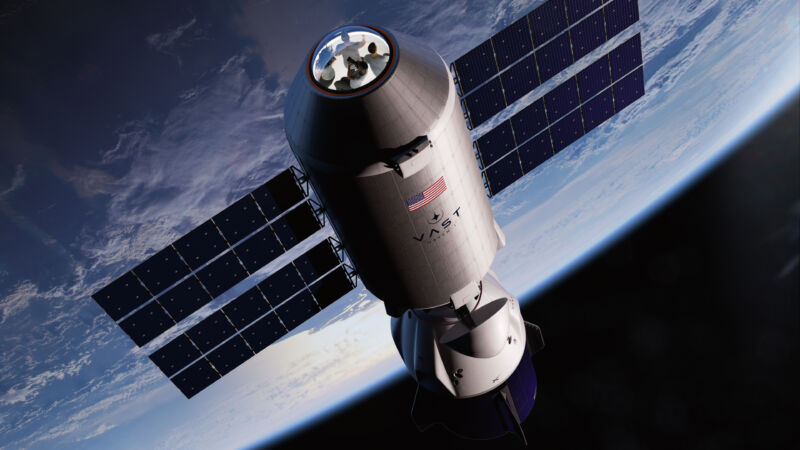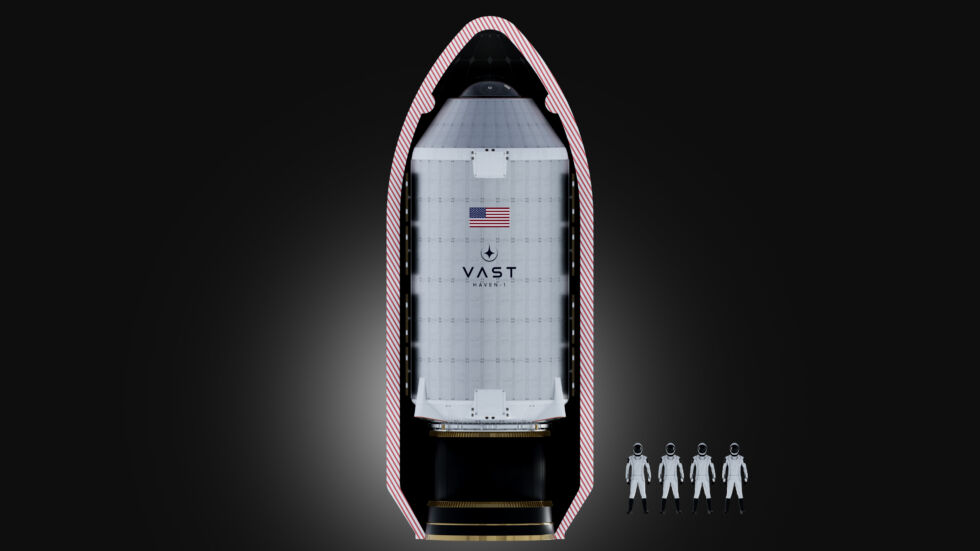VAST AMBITIONS —
Vast says it will launch its first space station in 2025 on a Falcon 9
"We have a clear path for how we're going to get there."

A private space station company, Vast, announced on Wednesday that it intends to launch a commercial space station as soon as August 2025. After deploying this "Haven-1" space station in low-Earth orbit, four commercial astronauts will launch to the facility on board SpaceX's Crew Dragon vehicle.
The California-based company says this crew will then spend about 30 days on board the Haven-1 space station before returning to Earth. As part of Wednesday's announcement, Vast said those four crewed seats are now up for sale, as are those for a second mission that will launch no earlier than 2026.
"It's a super aggressive schedule," Jed McCaleb, the founder of Vast, said in an interview with Ars. "But we have a clear path for how we're going to get there."
Getting to orbit fast
McCaleb founded Vast in 2021 to develop the world's first space station with artificial gravity. The company's plans are ambitious, and launching a habitable space station by 2025 would indeed represent a remarkably fast development time.
However, Vast has some credibility, both because of the funding McCaleb is able to pump into the company and because it has signed up several important technical advisers who had long careers at SpaceX, including Hans Koenigsmann, Will Heltsley, and Yang Li. An early pioneer in blockchain technology, McCaleb created Mt. Gox, the first major Bitcoin exchange. He is estimated by Forbes to be worth $2.4 billion and has vowed to invest more than $300 million into Vast Space as it seeks to develop space stations.
The partnership with SpaceX is the key to making this mission happen. Not only will the 3.8-meter-wide Haven-1 module launch inside a Falcon 9 rocket, but part of its life-support systems will also be provided by the Crew Dragon spacecraft when the vehicle is docked.
The Dragon spacecraft will remain powered on the entire time it is attached to Haven-1, providing some of the consumables such as air or water and other services needed to keep humans alive. By leaning on SpaceX and its experience developing these life support systems for Dragon, Vast will attempt to develop a space station on a quicker timeline.
McCaleb said the program has support from the leadership at SpaceX—which is important, as that company devotes much of its time and energy to developing the next-generation Starship rocket.
"A commercial rocket launching a commercial spacecraft with commercial astronauts to a commercial space station is the future of low-Earth orbit, and with Vast, we’re taking another step toward making that future a reality," said Tom Ochinero, senior vice president of commercial business at SpaceX, in a statement. "The SpaceX team couldn’t be more excited to launch Vast’s Haven-1 and support their follow-on human spaceflight missions to the orbiting commercial space station."
Doing so safely
In terms of crew safety, Vast intends to launch the space station into a 500-km orbit at the same inclination as the International Space Station. There, the module will be tested for a few weeks to ensure that everything is working. The first crew will then launch to Haven-1, and, should there be any problems during the stay, Dragon will be ready to depart almost immediately.
Vast's announcement comes as NASA is hoping that private companies will begin to offer habitation for its astronauts in low-Earth orbit. The space agency is planning to decommission the aging International Space Station by about 2030, after which time the agency plans to lease crew time on commercial space stations.
Presently, NASA is funding the development of four commercial space stations in low-Earth orbit; the stations are being built by Axiom Space, Blue Origin, Nanoracks, and Northrop Grumman. All four of these stations remain in the design or preliminary development phases, and all face questions about funding, commitment, or technology challenges.
In short, the competition remains open, and there is time for other entrants to obtain NASA funding in future years for commercial space stations.

Vast intends to go after some of this funding, and it potentially has some advantages in the competition. A station with artificial gravity may have some attractiveness to NASA, and McCaleb has deeper pockets than most of the other ventures outside of Blue Origin, which is backed by Amazon founder Jeff Bezos.
To meet NASA's needs, Vast is planning to launch a larger "Starship-class module" by around 2028. This will be nearly twice as large as Haven-1, with a seven-meter diameter, and it will launch atop SpaceX's Starship rocket. (The International Space Station modules are 4.2 meters in diameter.) Vast has published a roadmap of its plans all the way out to the 2040s.
McCaleb said Vast opted to start with the smaller Haven-1 station so that it could start flying sooner on proven SpaceX rockets and demonstrate to its customers and NASA the viability of its hardware in actual flight-like conditions.
The company is planning some artificial gravity experiments on Haven-1—it should be able to reach approximately lunar gravity, or one-sixth that of Earth's gravity. It is hoping for a more robust artificial gravity setup with the Starship module later this decade.
Eric Berger is the senior space editor at Ars Technica, covering everything from astronomy to private space to wonky NASA policy, and author of the book Liftoff, about the rise of SpaceX. A certified meteorologist, Eric lives in Houston.
No comments:
Post a Comment